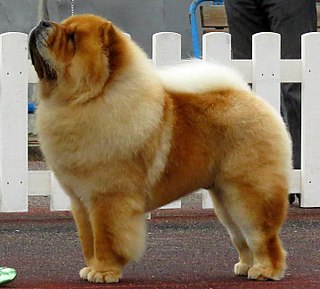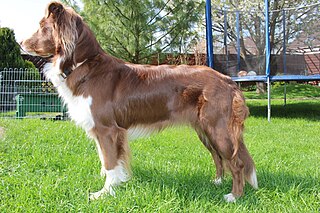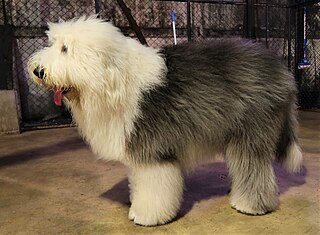Related Research Articles

The Chow Chow is a spitz-type of dog breed originally from Northern China. The Chow Chow is a sturdily built dog, square in profile, with a broad skull and small, triangular, erect ears with rounded tips. The breed is known for a very dense double coat that is either smooth or rough. The fur is particularly thick in the neck area, giving it a distinctive ruff or mane appearance. The coat may be shaded/self-red, black, blue, cinnamon/fawn, or cream.

The Border Collie is a British breed of herding dog of the collie type of medium size. It originates in the region of the Anglo-Scottish border, and descends from the traditional sheepdogs once found all over the British Isles. It is kept mostly as a working sheep-herding dog or as a companion animal. It competes with success in sheepdog trials. It has been claimed that it is the most intelligent breed of dog.

The Pomeranian is a breed of dog of the Spitz type that is named for the Pomerania region in north-west Poland and north-east Germany in Central Europe. Classed as a toy dog breed because of its small size, the Pomeranian is descended from larger Spitz-type dogs, specifically the German Spitz.

The Boxer is a medium to large, short-haired dog breed of mastiff-type, developed in Germany. The coat is smooth and tight-fitting; colors are fawn or brindled, with or without white markings. Boxers are brachycephalic, have a square muzzle, mandibular prognathism, very strong jaws, and a powerful bite ideal for hanging on to large prey. The Boxer was bred from the Old English Bulldog and the now extinct Bullenbeisser, which became extinct by crossbreeding rather than by a decadence of the breed. The Boxer is a member of both The Kennel Club and American Kennel Club (AKC) Working Group.

Cryptorchidism, also known as undescended testis, is the failure of one or both testes to descend into the scrotum. The word is from Ancient Greek κρυπτός (kryptos) 'hidden' and ὄρχις (orchis) 'testicle'. It is the most common birth defect of the male genital tract. About 3% of full-term and 30% of premature infant boys are born with at least one undescended testis. However, about 80% of cryptorchid testes descend by the first year of life, making the true incidence of cryptorchidism around 1% overall. Cryptorchidism may develop after infancy, sometimes as late as young adulthood, but that is exceptional.

The Australian Shepherd is a breed of herding dog from the United States. The name of the breed is technically a misnomer, as it was developed in California in the 19th century. It is believed to have its origins in sheepdog breeds from northwest Spain, as well as collies imported, alongside sheep, from Australia and New Zealand; the breed reportedly took its name from this trade. Originally used solely as a herding dog, the Australian Shepherd has become one of the most popular companion dog breeds in North America.

The French Bulldog is a French breed of companion dog or toy dog. It appeared in Paris in the mid-nineteenth century, apparently the result of cross-breeding of Toy Bulldogs imported from England and local Parisian ratters. It is commonly kept as a pet and is among the most frequently registered dogs in a number of countries including Australia, the United Kingdom, and the United States. The breed is susceptible to various health problems as a consequence of being bred for a distinctive appearance, sporting a brachycephalic face and skin wrinkles.

The Old English Sheepdog is a large breed of dog that emerged in England from early types of herding dog. Other names for the breed include Shepherd's Dog and bob-tailed sheep-dog. The nickname Bob-tail originates from how dogs of the breed traditionally had their tails docked. Old English Sheepdogs can grow very long coats with fur covering the face and eyes and do not shed unless brushed.

A luxating patella, sometimes called a trick knee, is a condition in which the patella, or kneecap, dislocates or moves out of its normal location. It can be associated with damage to the anterior cruciate ligament.

Merle is a genetic pattern in a dog's coat and alleles of the PMEL gene. It results in different colors and patterns and can affect any coats. The allele creates mottled patches of color in a solid or piebald coat, blue or odd-colored eyes, and can affect skin pigment as well. Two types of colored patches generally appear in a merle coat: brown/liver and black. Associated breeds include Carea Leonés, Australian Shepherds and Catahoula Leopard Dogs. Health issues are more typical and more severe when two merle-patterned dogs are bred together.

The Dobermann is a German breed of medium-large working dog of pinscher type. It was originally bred in Thuringia in about 1890 by Louis Dobermann, a tax collector. It has a long muzzle and – ideally – an even and graceful gait. The ears were traditionally cropped and the tail docked, practices which are now illegal in many countries.

The Dogue de Bordeaux, also known as the Bordeaux Mastiff, French Mastiff or Bordeauxdog, is a large French mastiff breed. A typical brachycephalic mastiff breed, the Bordeaux is a very powerful dog, with a very muscular body.

The health of dogs is a well studied area in veterinary medicine.

Cancer is the leading cause of death in dogs. It is estimated that 1 in 3 domestic dogs will develop cancer, which is the same incidence of cancer among humans. Dogs can develop a variety of cancers and most are very similar to those found in humans. Dogs can develop carcinomas of epithelial cells and organs, sarcomas of connective tissues and bones, and lymphomas or leukemias of the circulatory system. Selective breeding of dogs has led certain pure-bred breeds to be at high-risk for specific kinds of cancer.

Cat genetics describes the study of inheritance as it occurs in domestic cats. In feline husbandry it can predict established traits (phenotypes) of the offspring of particular crosses. In medical genetics, cat models are occasionally used to discover the function of homologous human disease genes.

The Shar Pei is a dog breed from southern China. Traditionally kept as a property guardian, the shar pei was driven to the brink of extinction in the 20th century. The breed is known in the West for its deep wrinkles, while a traditional less wrinkled form is maintained in Hong Kong.

The Dalmatian is a breed of dog with a white coat marked with dark-coloured spots. Originally bred as a hunting dog, it was also used as a carriage dog in its early days. The origins of this breed can be traced back to Croatia and its historical region of Dalmatia. It is thought that early ancestors of the breed were certain breeds of pointers and a spotted Great Dane. Today, it is a popular pet and many enthusiasts enter Dalmatians into kennel club competitions.

Congenital sensorineural deafness occurs commonly in domestic cats with a white coat. It is a congenital deafness caused by a degeneration of the inner ear. Deafness is far more common in white cats than in those with other coat colours.

The Chihuahua is a Mexican breed of toy dog. It is named for the Mexican state of Chihuahua and is the smallest dog breed in the world. It is usually kept as a companion animal.
References
- ↑ Suga, F; Hattler, K. W. (1970). "Physiological and histopathological correlates of hereditary deafness in animals". The Laryngoscope. 80 (1): 81–104. doi:10.1288/00005537-197001000-00007. PMID 5411826. S2CID 38837197.
- ↑ Nakai, Yoshiaki; Nakai, Sumiko (1971). "Ototoxic effect of nitromin and some congenital deaf animal cochlea. An electron microscopical study". Archiv für Klinische und Experimentelle Ohren- Nasen- und Kehlkopfheilkunde. 198 (3): 325–38. doi:10.1007/BF00316933. PMID 4255010. S2CID 6367897.
- ↑ Strain, G. M. (2010, October 5). DEAFNESS IN DOGS & CATS [Reference Site]. Retrieved October 10, 2010, from Louisiana State University website: http://www.lsu.edu/deafness/deaf.htm
- ↑ Famula, Thomas R; Cargill, Edward J; Strain, George M (2007). "Heritability and complex segregation analysis of deafness in Jack Russell Terriers". BMC Veterinary Research. 3: 31. doi: 10.1186/1746-6148-3-31 . PMC 2194672 . PMID 17999773.
- ↑ Cvejic, D; Steinberg, T. A.; Kent, M. S.; Fischer, A (2009). "Unilateral and bilateral congenital sensorineural deafness in client-owned pure-breed white cats". Journal of Veterinary Internal Medicine. 23 (2): 392–5. doi: 10.1111/j.1939-1676.2008.0262.x . PMID 19192155.
- ↑ Strain, G. M.; Clark, L. A.; Wahl, J. M.; Turner, A. E.; Murphy, K. E. (2009). "Prevalence of deafness in dogs heterozygous or homozygous for the merle allele". Journal of Veterinary Internal Medicine. 23 (2): 282–6. CiteSeerX 10.1.1.693.7956 . doi:10.1111/j.1939-1676.2008.0257.x. PMID 19192156.
- ↑ Wilkes, Gary. "Why the Deaf Dog Barks" . Retrieved 2008-12-31.